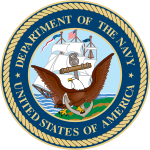List of battleships of the United States Navy
 |
| Ships of the United States Navy |
|
A–B • C • D–F • G–H |
| Aircraft carriers |
| Airships |
| Amphibious warfare ships |
| Auxiliaries |
| Battleships |
| Cruisers |
| Destroyers |
| Destroyer escorts |
| Escort carriers |
| Frigates |
| Mine warfare vessels |
| Monitors |
| Patrol vessels |
| Sailing frigates |
| Steam frigates |
| Steam gunboats |
| Ships of the line |
| Sloops of war |
| Submarines |
| Torpedo boats |
This list of battleships of the United States Navy includes all ships with the hull classification symbol "BB". A number of these were started but never completed.
American battleships can be roughly divided into five groups, coast defence battleships, pre-dreadnoughts, dreadnoughts, standards and World War II ships [1].
Contents |
Late 1800s - 1900s
Maine and Texas were part of the "New Navy" program of the 1880s. They, and BB-1 to BB-4 were authorised as "coast defence battleships"[2]. The next group, BB-5 Kearsarge through BB-25 New Hampshire, followed general global pre-dreadnought design characteristics and entered service between 1900 and 1909. The definitive American predreadnought was the penultimate class of the type, the Connecticut class, sporting the usual four-gun array of 12" weapons, a very heavy intermediate and secondary battery, and a moderate tertiary battery. They were good sea boats and heavily armed and armored for their type. The final American predreadnought class, the Mississippi-class second-class battleships, were a poorly thought out experiment in increasing numbers regardless of quality, and the USN quickly wished to replace them, doing so in 1914, selling them to Greece to pay for a new dreadnought battleship, USS Idaho.
The dreadnoughts, BB-26 South Carolina through BB-35 Texas, commissioned between 1910 and 1914, uniformly possessed twin turrets, introduced the superimposed turret arrangement that would later become standard on all battleships, and had relatively heavy armor and moderate speed (19-21 knots). Five of the ten ships favored the more mature vertical triple expansion (VTE) propulsion over fuel-inefficient but faster direct-drive turbines. The ships possessed 8 (South Carolina class), 10 (Delaware and Florida) or 12 (Wyoming class) 12" guns, or 10 (New York class) 14" guns. The dreadnoughts gave good service, the last two classes surviving through World War II before being scrapped. However, they had some faults that were never worked out, and the midships turrets in the ten and twelve-gun ships were located near boilers and high-pressure steam lines, a factor that made refrigeration very difficult and problematic in hot climates. One of their number, Texas (BB-35) is the last remaining American battleship of the pre-World War II era.
Next came the twelve Standards, beginning with BB-36 Nevada. The last ship commissioned was BB-48 West Virginia (BB-49 through 54 were also Standards, but were never commissioned, and scrapped under the Washington Naval Treaty), commissioned over the period 1914 to 1920. Oklahoma (BB-37) was the last American battleship commissioned with triple expansion machinery, all other Standards and the World War II ships used geared steam turbines. The Standards were a group of ships with four turrets, a 21-knot top speed, a 700 yard tactical diameter at top speed, and heavy armor distributed on the "All or Nothing" principal. Armament was fairly consistent, starting with ten 14" guns in the Nevadas, twelve in the Pennsylvanias, New Mexicos and Tennessees, and eight 16" guns in the Colorados. Oklahoma (BB-37) was the last American capital ship (battleship or fleet carrier) to be equipped with reciprocating engines.
Mid to late 1900s
After the 1930s "builders holiday," the USN commissioned ten more battleships of an entirely new style, the World War II group. These ships began with BB-55 North Carolina and the last ship laid down was BB-66 Kentucky (the last ship completed was BB-64 Wisconsin). These ships were a nearly clean break from previous American design practices. All ten ships were built to a Panamax design (technically post-Panamax, as they exceeded normal Panamax beam by two feet, but they were still able to transit the canal). They were fast battleships, and could travel with the aircraft carriers at cruising speed (their speed was not intended for that role, but rather so they could run down and destroy enemy battlecruisers). They possessed almost completely homogenous main armament (nine 16" guns in each ship, the sole difference being an increase in length from 45 to 50 calibres with the Iowa class vessels), very high speed relative to older American designs (28 knots in the North Carolina and South Dakota classes, 33 in the Iowa class), and moderate armor. The North Carolinas were of particular concern, as their protection was rated as only "adequate" against the 16" superheavy weapon. They had been designed with, and armored against, a battery of three quadruple 14" guns, then changed to triple 16" guns after the escalator clause in the Second London Naval Treaty had been triggered. Secondary in these ships was almost homogenous as well: Except for South Dakota, configured as a flagship, the other nine ships of this group sported a uniform 20-gun 5" secondary battery (South Dakota deleted two 5" mounts to make room for flag facilities). Visually, the World War II ships are distinguished by their triple-turret arrangement and the massive columnar mast that dominates their superstructure. The last ship, Wisconsin (BB-64), commissioned in 1944 (Wisconsin was approved last; however, Missouri commissioned 3 months later, due to delays from additional aircraft carrier construction). Missouri (BB-63), famous for being the ship on which the Japanese instrument of surrender was signed, was the last battleship in the world to decommission on March 31, 1992. Seven of these ten ships are still in existence as of 2006. South Dakota, Washington and Indiana were scrapped, but the remainder are either now museum ships or (Iowa) slated to become museum ships. There was intended to be another class of five of these ships, the Montana class (BB-67 Montana through BB-71 Louisiana), but they were canceled before being laid down in favor of a greater number of aircraft carriers. The Montana class ships would have been built to a post-Panamax design, and carried a greater number of guns (12x 16") than the other ships; otherwise they would have been homogenous with the rest of the World War II battleships. Seven battleships (BB 72 through BB 78) were projected in 1942. Armament was to consist of 8 × 18" in four double turrets. The project did not proceed past the drawing stage; none were ordered.
In 2006 the last battleship was stricken from the Naval Registry.
Ship list
- (s) indicates ship was second class battleship (relative to other US battleships of the era)
- (n) indicates ship never entered service.
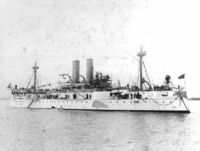
USS Maine
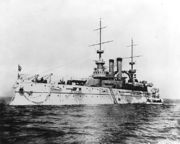
USS Wisconsin (BB-9)
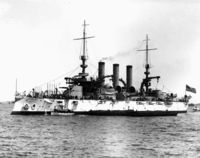
USS New Jersey (BB-16)
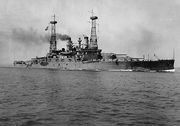
USS South Carolina (BB-26)
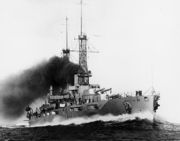
USS New York (BB-34)
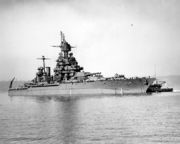
USS Maryland (BB-46)
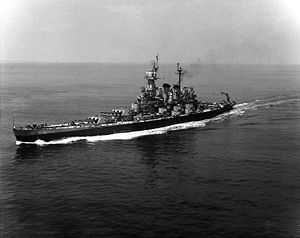
USS North Carolina (BB-55)
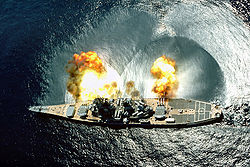
USS Iowa (BB-61) in 1984
|
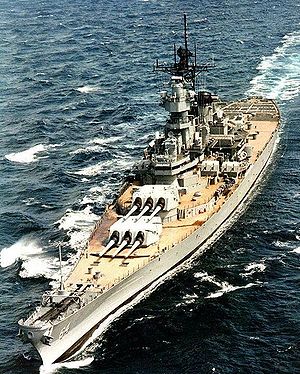
USS Wisconsin (BB-64)
|
Except for Kearsarge, named by an act of Congress, all American battleships have been named for states, and every state has had at least one battleship named for it except Alaska and Hawaii. They did not become states until 1959, after the end of battleship building, although the Large Cruisers USS Alaska (CB-1) and USS Guam (CB-2) were built during WWII. The third of the class, USS Hawaii (CB-3), was never completed. Two battleships have been authorized to be named for Montana, but both were canceled before commissioning. The pre-dreadnoughts USS Zrinyi (formerly the Austrian SMS Zrinyi), USS Radetzky (formerly the Austrian SMS Radetzky), and USS Ostfriesland (formerly the German SMS Ostfriesland), taken as prizes of war after World War I, were commissioned in the US Navy, but were not assigned hull classification symbols.
No American battleship has ever been lost at sea, though some have been sunk in port and others sunk as targets.
Battleship classes
Coast Defence types

USS Maine
- Displacement: 6,682 tons
- Armament: 4 × 10 in (250 mm) (2x2 en echelon); 6 × 6 in (152 mm) (6x1); 7 x 6 pounders (37 mm) (7x1); 8 x 1 pounders (0.5 kg) (8x1); 4 × 14 in (350 mm) surface torpedo tubes
- Speed: 17 knots
- Ships in class: 1
- Commissioned: 17 September 1895
- Fate: Sunk by explosion 15 February 1898
.jpg)
USS Texas
- Displacement: 6,682 tons
- Armament: 2 × 12 in (305 mm) (2x1 en echelon); 6 × 6 in (152 mm) (6x1); 12 x 6 pounders (2.7 kg) (12x1); 6 x 1 pounders (6x1); 4 then 2 (fore and aft tubes removed 1897) x 14 inch (356 mm) torpedo tubes
- Speed: 18 knots
- Ships in class: 1
- Commissioned: 15 August 1895
- Fate: Decommissioned 1 February 1911, then sunk as a target in Tangier Sound in Chesapeake Bay.
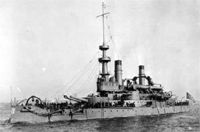
Indiana class
- Displacement: 10,288 tons
- Armament: 4 × 13 in (330 mm) (2x2), 8 × 8 in (203 mm) (4x2), 4 × 6 in (152 mm) (4x1), 20 x 6-pounders (20x1), 6 x 1-pounders (6x1), 4 Gatling guns (4x1), 6 × 18 in (457 mm) surface torpedo tubes
- Speed: 15 knots
- Ships in class: 3: USS Indiana, USS Massachusetts, and USS Oregon
- Commissioned: 20 November 1895
- Fate: Decommissioned 17 July 1920; Indiana and Massachusetts sunk as targets; Oregon preserved as memorial 1936, scrapped 1956

USS Iowa
- Displacement: 11,346 tons
- Armament: 4 × 12 in (305 mm) (2x2), 8 × 8 in (203 mm) (4x2), 6 × 4 in (102 mm) guns (6x1), 20 x 6-pounders (20x1), 4 x 1-pounders (4x1), 4 × 14 in (356 mm) torpedo tubes
- Speed: 17 knots
- Ships in class: 1
- Commissioned: 16 June 1897
- Fate: Decommissioned 31 March 1919, then sunk as bombing target.
Pre-Dreadnought types
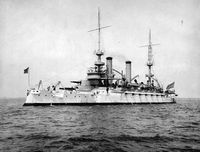
Kearsarge class
- Displacement: 11,540 tons
- Armament: 4 × 13 in (330 mm) (2x2), 4 × 8 in (203 mm) (2x2), 14 × 6 in (152 mm) (14x1), 20 x 6-pounders (20x1), 8 x 1-pounders (8x1), 4 x 30-caliber machineguns
- Speed: 15 knots
- Ships in class: 2: USS Kearsarge and USS Kentucky
- Commissioned: 20 February 1900
- Fate: Decommissioned 29 May 1920
_1912.jpg)
Illinois class
- Displacement: 11,565 tons
- Armament: 4 × 13 in (330 mm) (2x2), 14 × 6 in (152 mm) (14x1), 16 x 6 pounders (2.7 kg) (16x1), 6 x 1 pounders (454 g) (6x1), 4 torpedo tubes
- Speed: 17 knots
- Ships in class: 3: USS Illinois, USS Alabama, and USS Wisconsin
- Commissioned: 16 October 1900
- Fate: Decommissioned 17 July 1920

Maine class
- Displacement: 12,500 tons
- Armament: 4 × 12 in (305 mm) (2x2), 16 × 6 in (152 mm) (16x1), 6 × 3 in (76 mm) (6x1), 8 x 3-pounder guns (8x1), 6 x 1-pounders (6x1), 3 x .30-caliber machine guns (3x1), 2 × 18 in (457 mm) submerged torpedo tubes
- Speed: 18 knots
- Ships in class: 3: USS Maine, USS Missouri, and USS Ohio
- Commissioned: 29 December 1902
- Fate: Decommissioned 31 May 1922

Virginia class
- Displacement: 15,000 tons
- Armament: 4 × 12 in (305 mm) (2x2), 8 × 8 in (203 mm) (4x2), 12 × 6 in (152 mm) guns (12x1), 24 1-pounders (24x1), 4 × 21 in (533 mm) torpedo tubes
- Armor: Belt 11 inches; Turret 12 inches; Deck 3 inches
- Speed: 19 knots
- Ships in class: 5: USS Virginia, USS Nebraska, USS Georgia, USS New Jersey, and USS Rhode Island
- Commissioned: 19 February 1902
- Fate: Decommissioned 13 August 1920
Connecticut class
- Displacement: 16,000 tons
- Armament: 4 × 12 in (305 mm) (2x2), 8 × 8 in (203 mm) (4x2), 12 × 7 in (178 mm) (12x1), 10 × 3 in (76 mm) (10x1), 4 × 21 in (533 mm) torpedo tubes
- Armor:
- Speed: 18 knots
- Ships in class: 6: USS Connecticut, USS Louisiana, USS Vermont, USS Kansas, USS Minnesota, and USS New Hampshire
- Commissioned: 1906
- Fate: Decommissioned 1923
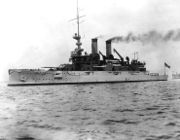
Mississippi class
- Displacement: 13,000 tons
- Armament: 4 × 12 in (305 mm) (2x2), 8 × 8 in (203 mm) (4x2), 8 × 7 in (178 mm) (8x1), 12 × 3 in (76 mm) (12x1), 6 x 3 pounder gun (6x1), 2 x 1-pounder Mark 6 (2x1), 6 x .30-caliber machine guns (6x1), 2 × 21 in (533 mm) torpedo tubes
- Armor:
- Speed: 17 knots
- Ships in class: 2: USS Mississippi and USS Idaho
- Commissioned: 1 February 1908
- Fate: Decommissioned 30 July 1914 and sold to Greece. Ex-Mississippi and ex-Idaho sunk by German bombers in April 1941.
Dreadnought era

South Carolina class
- Displacement: 16,000 tons
- Armament: 8 × 12 in (305 mm) guns (4x2), 22 × 3 in (76 mm) (22x1), 2 x 3 pounder (2x1), 2 × 21 in (533 mm) torpedo tubes
- Armor:
- Speed: 17 knots
- Ships in class: 2: USS South Carolina and USS Michigan
- Commissioned: both in 1910
- Fate: Decommissioned 1921 and 1922, both sold for scrap

Delaware class
- Displacement: 20,380 tons
- Armament: 10 × 12 in (305 mm) (5x2), 14 × 5 in (127 mm) (14x1), 22 × 3 in (76 mm) (22x1), 2 x 3 pounder (2x1) guns, 2 × 21 in (533 mm) torpedo tubes
- Armor:
- Speed: 21 knots
- Ships in class: 2: USS Delaware and USS North Dakota
- Commissioned: both in 1910
- Fate: both decommissioned 1923 and sold for scrap

Florida class
- Displacement: 21,800 tons
- Armament: 10 × 12 in (305 mm) (5x2), 16 × 5 in (127 mm) (16x1), 2 × 21 in (533 mm) torpedo tubes
- Armor:
- Speed: 21 knots
- Ships in class: 2: USS Florida and USS Utah
- Commissioned: both in 1911
- Fate: Florida scrapped in 1932, Utah became target ship (AG-16) in 1931, sunk at Pearl Harbor in 1941

Wyoming class
- Displacement: 27,200 tons
- Armament: 12 × 12 in (305 mm) (6x2), 21 × 5 in (127 mm) (21x1), two 3-inch (3x1), 2 × 21 in (533 mm) torpedo tubes
- Armor:
- Speed: 21 knots
- Ships in class: 2: USS Wyoming and USS Arkansas
- Commissioned: both in 1912
- Fate: Wyoming became a training ship (AG-17) in 1931, decommissioned in 1947. Arkansas sunk at Operation Crossroads in 1946
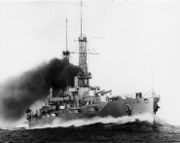
New York class
- Displacement: 27,200 tons
- Armament: 10 × 14 in (356 mm) (5x2), 21 5-inch (21x1), two 3-inch (2x1), 2 × 21 in (533 mm) torpedo tubes
- Armor:
- Speed: 21 knots
- Ships in class: 2: USS New York and USS Texas
- Commissioned: both in 1914
- Fate: New York sunk as target in 1948, Texas preserved as a memorial 1948
Standard type
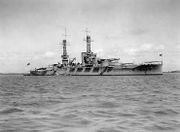
Nevada class
- Displacement: 27,500 tons
- Armament: 10 × 14 in (356 mm) (2x3, 2x2), 21 × 5 in (127 mm) (21x1), 4 × 21 in (533 mm) torpedo tubes
- Armor:
- Speed: 20 knots
- Ships in class: 2: USS Nevada and USS Oklahoma
- Commissioned: both in 1916
- Fate: Nevada sunk as target 1948; Oklahoma sunk at Pearl Harbor in 1941, raised and stripped of salvageable parts, sunk in route to scrapping 1947

Pennsylvania class
- Displacement: 31,400 tons
- Armament: 12 × 14 in (356 mm) (4x3), 14 × 5 in (127 mm) (14x1), 4 × 3 in (76 mm) (4x1), 2 × 21 in (533 mm) torpedo tubes
- Armor:
- Speed: 21 knots
- Ships in class: 2: USS Pennsylvania and USS Arizona
- Commissioned: both in 1916
- Fate: Pennsylvania sunk after Operation Crossroads in 1946, Arizona destroyed at Pearl Harbor in 1941, designated as a memorial.

New Mexico class
- Displacement: 32,000 tons
- Armament: 12 × 14 in (356 mm) (4x3), 14 × 5 in (127 mm) (14x1), 2 × 21 in (533 mm) torpedo tubes
- Armor:
- Speed: 21 knots
- Ships in class: 3: USS New Mexico, USS Mississippi, and USS Idaho
- Commissioned: New Mexico in 1918, Mississippi in 1917 and Idaho in 1919
- Fate: sold for scrap, New Mexico & Idaho in 1947. Mississippi became trials ship (AG-128) in 1946, scrapped in 1956
Tennessee class

- Displacement: 32,000 tons
- Armament: 12 × 14 in (356 mm) (4x3), 14 × 5 in (127 mm) (14x1), 2 × 21 in (533 mm) torpedo tubes
- Armor:
- Speed: 21 knots
- Ships in class: 2: USS Tennessee, and USS California
- Commissioned: Tennessee in 1920, California in 1921
- Fate: both decommissioned 1947, sold for scrap 1959
Colorado class

- Displacement: 32,600 tons
- Armament: 8 × 16 in (406 mm) (4x2), 12 × 5 in (127 mm) (12x1), 8 × 3 in (76 mm) (8x1), 2 × 21 in (533 mm) torpedo tubes
- Armor:
- Speed: 21 knots
- Ships in class: 4: USS Colorado, USS Maryland, USS Washington, and USS West Virginia
- Commissioned: Maryland in 1921, Colorado and West Virginia in 1923, Washington not completed and sunk as target
- Fate: Remaining three decommissioned 1947 and sold for scrap 1959.
South Dakota class
- Displacement: 43,200 tons
- Armament: 12 × 16 in (406 mm) (4x3), 16 × 6 in (152 mm) (16x1), 8 × 3 in (76 mm) (8x1), 2 × 21 in (533 mm) torpedo tubes
- Armor:
- Speed: 23 knots
- Ships in class: 6: USS South Dakota, USS Indiana, USS Montana, USS North Carolina, USS Iowa, and USS Massachusetts
- Commissioned: None commissioned
- Fate: All cancelled prior to launch in 1923; scrapped on slip
World War II era
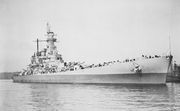
North Carolina class
- Displacement: 35,000 tons
- Armament: 9 × 16 in (406 mm) (3x3), 20 × 5 in (127 mm) (10x2), 16 x 1.1 inch AA (4x4)
- Armor: 11in Belt / 7in Deck
- Speed: 28 knots
- Ships in class: 2: USS North Carolina and USS Washington
- Commissioned: 1941
- Fate: North Carolina preserved as memorial 1965; Washington scrapped 1962
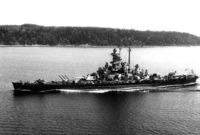
South Dakota class
- Displacement: 38,000 tons
- Armament: 9 × 16 in (406 mm) (3x3), 20 (16 on 'South Dakota) x 5 inch (10 or 8 x 2), up to 40 x 40mm AA (17x4), up to 76 x 20 mm AA (76x1), 3 aircraft
- Armor: 12in Belt / 7.5in Deck
- Speed: 27 knots
- Ships in class: 4: USS South Dakota, USS Indiana, USS Massachusetts, and USS Alabama
- Commissioned: 1942
- Fate: South Dakota and Indiana scrapped 1960;Alabama preserved as memorial 1964 Massachusetts preserved as memorial 1965
Iowa class
- Displacement: 48,500 tons
- Armament: 9 × 16 in (406 mm) (3x3), 20 × 5 in (127 mm) (10x2), 80 x 40mm AA (20x4), 49 x 20 mm AA (49x1) (1980s modification added 32 x Tomahawk and 16 x Harpoon missiles and 4 x Phalanx CIWS, and deleted 8 5-in guns and all other light anti-aircraft gun systems)
- Armor: 12in Belt / 8in Deck
- Speed: 33 knots
- Ships in class: 6: USS Iowa, USS New Jersey, USS Missouri, USS Wisconsin, USS Illinois, and USS Kentucky
- Commissioned: Four commissioned; first Iowa 1943; last Wisconsin 1944.
- Fate: Iowa in mothball fleet at Suisun Bay, California; Missouri preserved as memorial 1993 at Pearl Harbor; Wisconsin preserved as memorial Norfolk, Virginia; New Jersey preserved as memorial in Camden, NJ; Illinois cancelled and scrapped on slip; Kentucky launched 1950, not completed, scrapped 1958.

Montana class
- Displacement: 65,000 tons
- Armament: 12 × 16 in (406 mm) (4x3), 20 × 5 in (127 mm) (10x2), undesignated number of 40 mm and 20 mm
- Armor: 16in Belt / 8.2in Deck
- Speed: 28 knots
- Ships in class: 5: USS Montana, USS Ohio, USS Maine, USS New Hampshire, and USS Louisiana
- Commissioned: None commissioned
- Fate: All cancelled in 1943 before being laid down
Projected battleships
Seven battleships BB 72 through BB 78 were projected in 1942. Armament was to consist of 8 × 18 in (4x2), 20 x 5 in (10x2). The project did not proceed past the drawing stage; none were ordered.
See also
- Arsenal ship
- List of ships of the line of the United States Navy
References
External links
|
||||||||||||||||||||||||||||||||||
